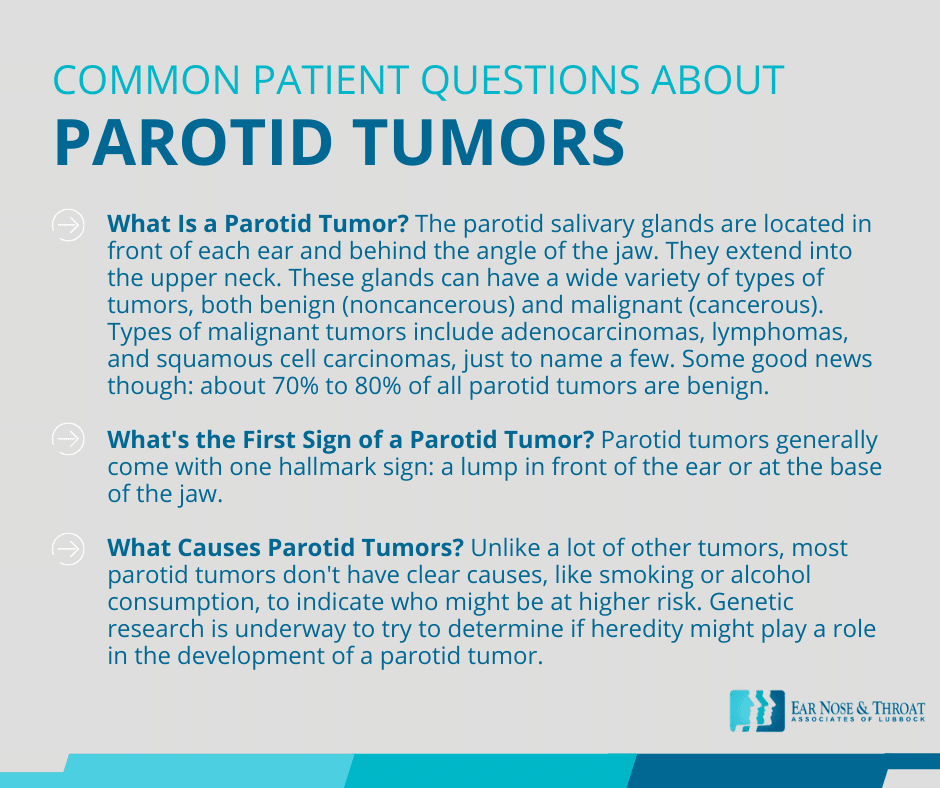Everything You Need To Know About Parotid Tumors

Only about six in 100,000 people will experience a parotid gland tumor. Far fewer will have a cancerous parotid tumor.
Parotid tumors aren’t a well-known health condition, but they can be easy to identify. Today we’d like to bring some awareness to this particular type of lesser-known condition and help you know when to see a doctor.
What Is a Parotid Tumor?
We each have three sets of salivary glands and ducts that keep our mouths moist and help begin the breakdown of the food we eat. These are the sublingual glands (under the tongue), the submandibular gland (under the floor of the mouth), and the parotid glands (in front of the ears).
The parotid salivary glands are located in front of each ear and behind the angle of the jaw. They extend into the upper neck.
These glands can have a wide variety of types of tumors, both benign (noncancerous) and malignant (cancerous). Types of malignant tumors include adenocarcinomas, lymphomas, and squamous cell carcinomas, just to name a few.
Some good news though: about 70% to 80% of all parotid tumors are benign.
One of the more common benign tumors is the pleomorphic adenoma. Although it’s benign, if left to itself it can actually become cancerous after a number of years. When this happens, the cancer is referred to as a carcinoma ex pleomorphic adenoma.
The bottom line is that even benign parotid tumors can be fairly aggressive, so it’s important to seek treatment. This is one of the reasons that most parotid tumors need to be removed.

What’s the First Sign of a Parotid Tumor?
Parotid tumors generally come with one hallmark sign: a lump in front of the ear or at the base of the jaw. Sometimes patients ignore this lump because it isn’t causing them any pain or discomfort.
But a lump in the parotid gland area generally indicates a parotid tumor, so you should get it checked out by an ENT doctor immediately.
What Causes Parotid Tumors?
Unlike a lot of other tumors, most parotid tumors don’t have clear causes, like smoking or alcohol consumption, to indicate who might be at higher risk.
Some skin cancers have been known to spread to the parotid glands. And one type of parotid tumor, a Warthin’s benign tumor, has been connected to smoking.
But for the time being, it seems that some people are just more prone to parotid tumors than others. Genetic research is underway to try to determine if heredity might play a role in the development of parotid tumors.
Treatment and Prognosis
The usual treatment for a parotid tumor is a surgery known as a parotidectomy.
The tricky part of performing a parotidectomy is that the facial nerve passes right through the parotid gland. The facial nerve is responsible for sensation and motor function in the entire face and tongue, so this procedure is not without risk.
The facial nerve has five main branches that supply the face and tongue. Fifteen percent of the parotid gland is below the facial nerve (farther away from your cheek), but the remaining 85% is on top of the facial nerve (closer to your cheek).
In order to remove a tumor from the parotid gland, the surgeon must dissect the facial nerve. Most tumors occur in the larger, upper part of the parotid gland. Some, however, can occur in the lower portion of the gland, making removal more difficult.
What Should I Do if I Think I Might Have a Parotid Tumor?
If there’s a lump in front of your ear or at the base of your jaw, there’s a good chance it could be a parotid tumor. Fortunately, most parotid tumors are benign. But like we mentioned above, some benign tumors can evolve into cancerous tumors, so you should see your doctor right away.
The ENT Associates of Lubbock medical team is experienced in diagnosing parotid tumors. We can help you get the treatment or referrals you need for the best prognosis possible. Reach out to our team today to schedule a consultation.
Dr. Scolaro is a board-certified Otolaryngologist servicing the South Plains area. He has been practicing in Lubbock since 1990 and has earned a reputation as a skilled and experienced surgeon. He currently serves as the Medical Director for Covenant High Plains Surgery Center campuses, is a member of Covenant Health Partners and is an adjunct faculty professor for Texas Tech University Health Sciences Center School of Medicine. Learn more about Dr. Scolaro.
Categories:








